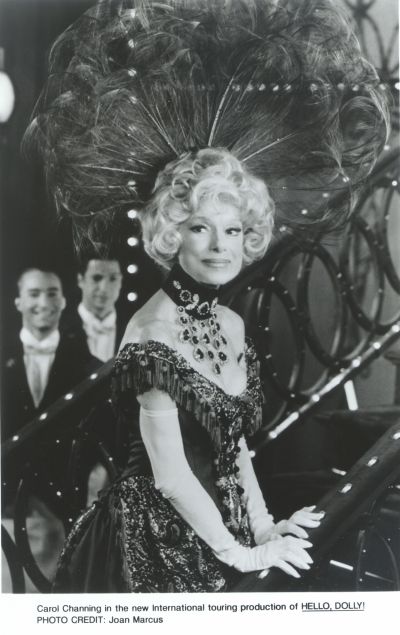Was introduced to Bleecker Bob’s yesterday afternoon by SarahB. While down to catch the Fringe production of How Now Dow Jones, we found ourselves with some time to browse through the cast album bin ($2 special on many popular favorites). As you may recall, I am a huge fan of record shopping. Not only do I enjoy the browsing, but I am always excited at the potential of finding a forgotten gem. I picked up Ballroom, Shenandoah, Coco, and the original off-Broadway cast of Hair. Now, not only do I like to collect the records, but I also like to play them. I sound older than my 26 years, but there is just something so incredibly satisfying about the sound of the needle hitting the vinyl. So while I played through a few platters, I decided to pop on Mame, just because. What I had never done before was read the back of the sleeve. I discovered here the most amusing artist biographies I think I’ve ever read and thought I’d share:
ANGELA LANSBURY (Mame) can do anything but wrong. She can be the good girl (The Picture of Dorian Gray), the bad girl (Gaslight), villainous mother (The Manchurian Candidate) or Elizabeth Taylor’s sister (National Velvet). Those were films. On stage she has ranged Bert Lahr’s farcical playmate in Hotel Paradiso to the dramatic demands of A Taste of Honey. Her previous musical outing, Anyone Can Whistle, proved that she can handle parades and miracles. MAME proves she can handle anything. And not only sing it, dance it and act it, but wear it, too. And beautifully.
JERRY HERMAN (Music and Lyrics) is a blooming Broadway industry. With four previous scores to his credit (two revues, plus Milk and Honey and Hello, Dolly!) he has a Tony Award, a gold record, a Grammy Award, 1964 citation from Variety as both the year’s “Best Composer” and “Best Lyricist,” and from station WPAT, for the song “Shalom,” a Gaslight award (no connection with Miss Lansbury’s movie). On top fo this he was chosen one of the Ten Outstanding Young Men by the United States Chamber of Commerce in 1965. Yes, he seems to have the knack of things, all right.
JEROME LAWRENCE and ROBERT E. LEE (Authors) began on Broadway with a musical, Look Ma, I’m Dancin’, starring Nancy Walker. But then they wrote a play, called Inherit the Wind, and the success of that classic theater piece kept them thinking in dramatic terms for some time. (Having a work translated into Urdu and Serbo-Croatian and twenty-six other languages can do that). But one of their subsequent plays was a masterful comedy named Auntie Mame from PATRICK DENNIS’ brilliantly funny novel. And now, with the musical MAME, they are bringing it all back home.
SYLVIA and JOSEPH HARRIS and ROBERT FRYER and LAWRENCE CARR (Producers) are a kind of musical Quartet. Each comes to production with significant individual credits. Fryer and Carr produced the original Auntie Mame, Desk Set, Advise and Consent and Gwen Verdon’s Redhead. Sylvia Harris coproduced Make a Million and Tovarich, and her husband Joseph has conquered virtually every known aspect of theatrical business management. Together the four launched their firstborn, Sweet Charity, and resuscitated not only the old Palace Theatre but an entire New York theatrical season. And here they come again.
GENE SAKS (Director) is a reformed actor. Since his first job as director, Enter Laughing, there’s been no time for acting, enviable as his reputation was. In the short time since that smash hit there have been Nobody Loves an Albatross, Generation and Half a Sixpence. In this last he worked with ONNA WHITE, reformed dancer, who has here staged the musical numbers and dances, as she did there. Miss White had previously been applauded for her assignments in The Music Man and Irma La Douce. From the look of it, mutual success makes happy collaborators.
And so we have the Fryer, Carr, Harris, Lansbury, Lawrence, Lee, Herman, Dennis, White, Saks ensemble. Enough to make up one of Mame’s posher, more intimate parties. Cheers!



